Have you ever walked into a house and felt immediate warmth, history, and vibrant life? You must have felt the intriguing beauty of Spanish house style. It is not a trend; it’s a timeless elegance with strong roots in centuries of vibrant culture, architecture, and passionate artistry. From Andalusia’s golden courtyards to California’s country haciendas, the essence of Spanish interior style speaks a universal dialect of comfort and beauty.
What makes Spanish houses so enticing? It’s a transcendent mix of nature textures, delicate ornamentation, and a color scheme that nods toward both the dynamic landscape and peaceful interiors of old Spain. If you’re looking to bring a novel personality to your home, a touch of old-world charm, and a dash of bright colors, then adopting the Spanish theme might be your next design adventure. This is where the magic of Spanish home style truly shines.
In this comprehensive guide, we’ll investigate the heart of Spanish home style, its unique characteristics, architectural elements, and how you can effortlessly incorporate this charming look into your own home. Get ready to discover the secrets that put these homes in a class of their own!
The Timeless Allure: Why Spanish Home Style Enchants
The enduring popularity of the Spanish style house stems from its unique ability to marry grandeur with an inviting, lived-in feel. It’s a style that celebrates craftsmanship, natural materials, and a deep connection to the outdoors. Whether you’re drawn to the rustic charm of an old Spanish house design or the sleek lines of modern Spanish home style, there’s an element that resonates with everyone. This allure is a hallmark of Spanish home style.
Consider: the cooling relief of heavy stucco walls on a hot day, the heat of terracotta tile beneath bare feet, the fancy touch of wrought iron, and the flamboyant swing of pattern in textiles and tiles. It’s not just about decoration; it’s about the design of atmosphere, a sensory trip that transports you into burning plazas and cozy, candlelit evenings. The distinct atmosphere of Spanish home style is truly captivating.
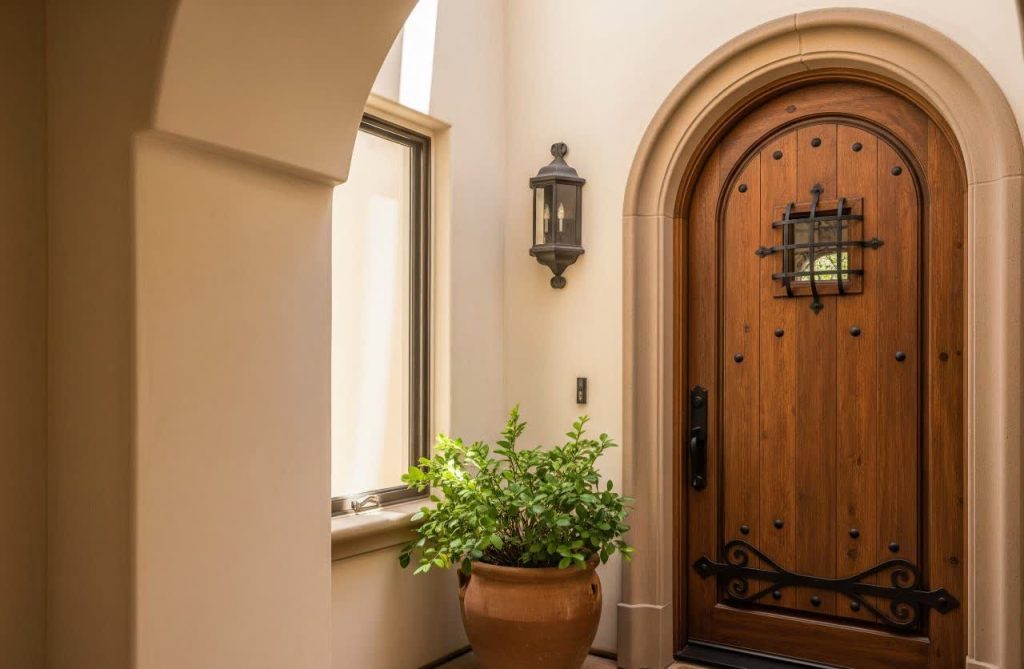
Revealing the Hallmarks of Spanish Style Interior Design
When we refer to Spanish home style interior design, there are certain very specific things that come to mind right away. They are the elements that lend themselves to that particular Spanish feel, defining what Spanish home style is all about.
Architectural Elements: The Soul of Spanish Character
The physical design of a Spanish-style home often dictates its appearance.
- Stucco Walls: A time-honored feature, often in warm white, cream, or terracotta. The textured, thick walls are excellent insulators and a rustic, old-world backdrop. They give that genuine Mediterranean feel, embodying Spanish home style.
- Terracotta Roof Tiles: The traditional reddish-orange barrel tiles are a signature of Spanish-influenced design, adding warmth and visual interest to the exterior. This is key to Spanish home style.
- Arched Doorways and Windows: Curves are this style’s trademark, softening the lines of a home and creating a feeling of fluidity and elegance. Arches can be applied in entranceways, interior doorways, and windows and often framed with dark wood or iron. They are characteristic of Spanish home style.
- Wooden Beams: Revealed dark, heavy wood beams, most commonly left in an unstained or stained condition, are a common feature on ceilings, creating a structural, rustic kind of beauty and a sense of history. This elevates the Spanish home style.
- Wrought Iron Details: From graceful grilles on windows and doors to stairway balustrades and lighting, wrought iron adds an infusion of elegant artfulness and robust beauty. Wrought iron detail is virtually emblematic of Spanish style.
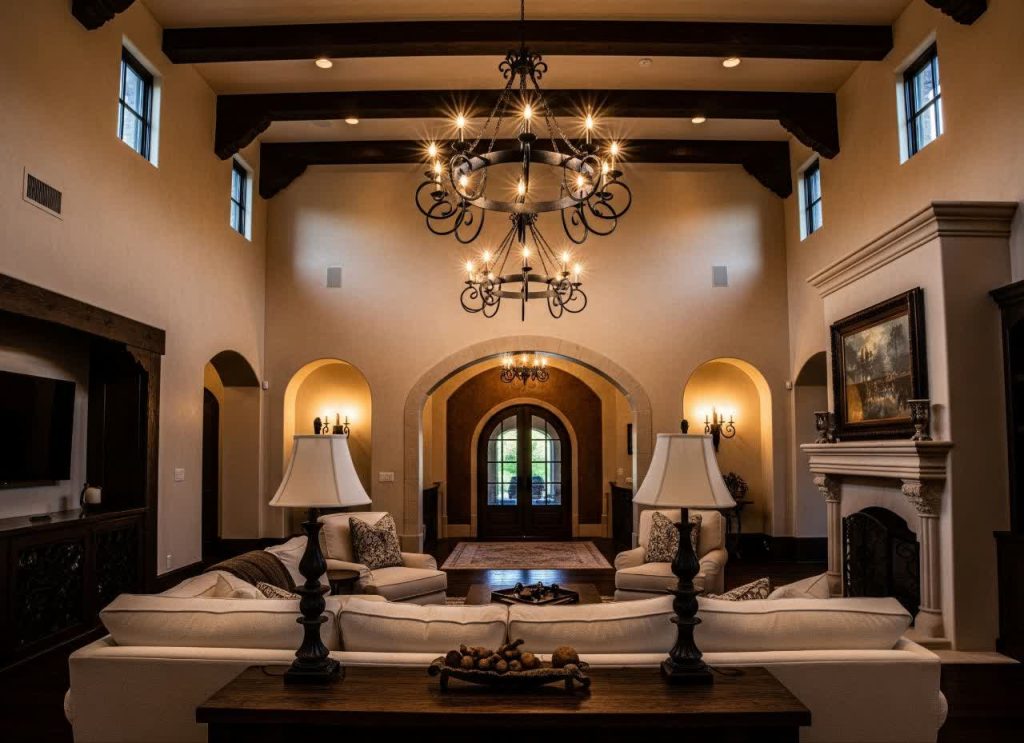
Color Palette: Earthy Tones and Sun-Drenched Hues
The Spanish home design color palette is a beautiful mix of vibrant and muted.
- Warm Neutrals: White, cream, beige, and light ochre form the foundation, reflecting and producing a light, airy texture, particularly in hot climates.
- Earthy Tones: Terracotta, burnt orange, deep reds, and rich browns are utilized as threads, frequently employed in tiles, pottery, and furniture.
- Bold Accents: Powerful blues, deep greens, and infrequent flashes of yellow or even fuchsia, particularly in fabric and ornamental tiles, bring energy and life. Think about the use of vibrant colors in Spanish ceramics or traditional wall painting, quintessential to Spanish home style.
Flooring: Stepping on Tradition
The floor of a home in Spanish style is as functional as it is beautiful, built to cool houses.
- Terracotta Tiles: Surprisingly, these are a top choice. Their warmth and robustness are perfect for high-traffic areas and provide a rustic foundation. Use Saltillo tiles for an authentic look. A classic for Spanish home style.
- Dark Hardwood: Rich, dark wood flooring provides a contrasting warmth and elegance, particularly in living rooms and bedrooms, typically installed in wide planks.
- Patterned Tiles (Encaustic & Talavera): These decorative tiles are used as a means to introduce splashes of color and detailed floral or geometric designs, often used as an accent, entryway, kitchen, bathroom, or even stair risers. These are essential for Spanish home style.
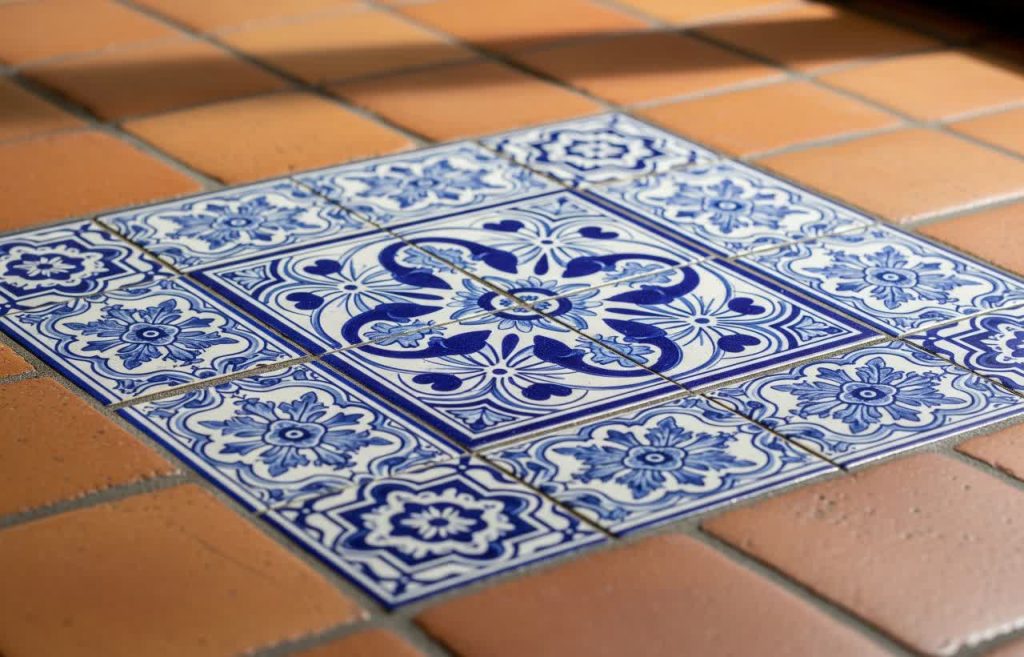
Furniture: Ornate and Strong
Spanish home decor embraces decorative and strong furniture.
- Dark Wood Furniture: Heavy, solid wood furniture, typically carved and ornate, is typical. Take dining tables, chairs, and cabinets made of woods like walnut, oak, or mahogany. This defines Spanish home style furniture.
- Wrought Iron Furniture: From beautifully carved bed frames to heavy coffee tables and decorative chairs, wrought iron brings a delicate yet heavy touch.
- Leather Upholstery: Luxurious, frequently aged leather, is used for sofas and chairs, bringing rustic luxury and longevity.
- Chests and Cabinets: Featured with intricate carvings or ironwork details, these storage units also serve as decorative pieces.
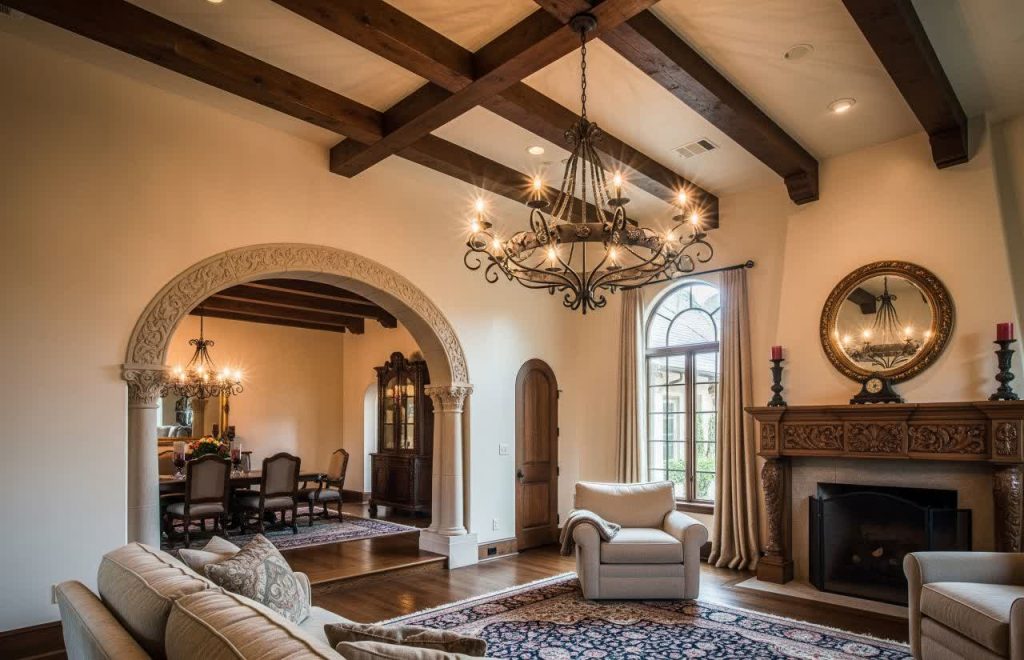
Textiles: Richness and Texture
Textiles make a valuable contribution to the warmth, color, and softness of the solid parts of Spanish home style.
- Heavy Drapes: Typically in deep reds, maroons, or rich browns, these provide privacy and insulation and bring an air of drama.
- Embroidered Fabrics: Look for cushions, throws, and tapestries with traditional Spanish embroidery, often floral or geometric motifs.
- Hand-Woven Rugs: Kilim or other hand-woven rugs in earth color or bold designs define spaces and add comfort.
- Damask and Velvet: These luxurious materials can be incorporated in accent pieces, adding a touch of outmoded opulence.
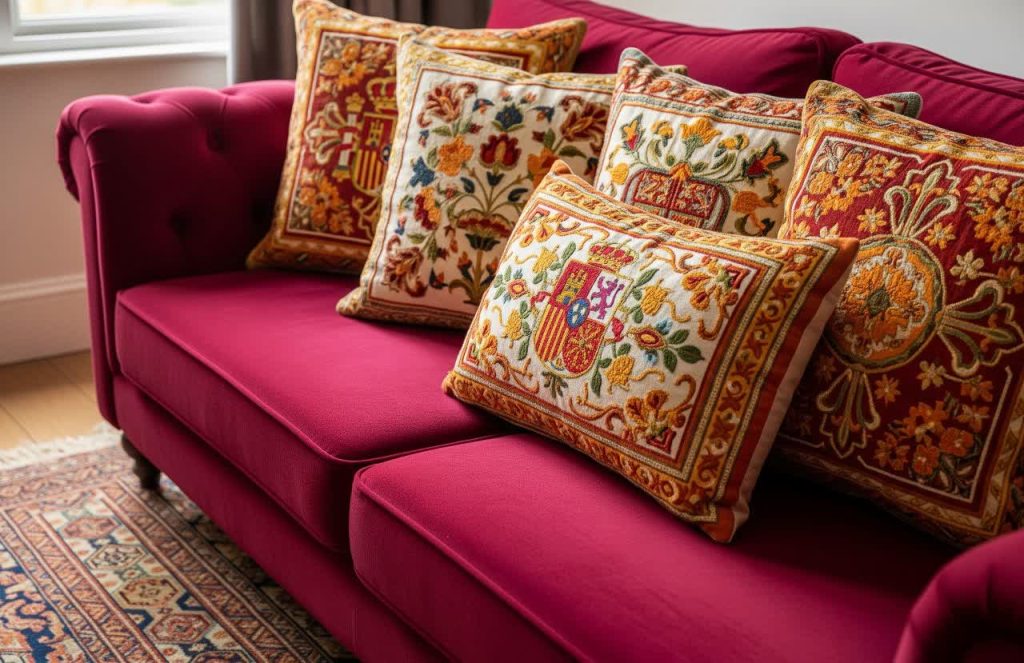
Lighting: Ambiance and Artistry
Lighting in a Spanish home is not just for the sake of utility; it is integral to the decor.
- Wrought Iron Chandeliers: Large and showy, a focal point in dining rooms or entryways. Essential for Spanish home style.
- Sconces and Lanterns: Wall sconces, often wrought iron and amber or frosted glass, provide a warm, ambient glow.
- Ceramic Lamps: Hand-painted ceramic lamp bases add a touch of handmade beauty and color.
- Candles: Candles in ornamental holders contribute to the cozy, inviting atmosphere.
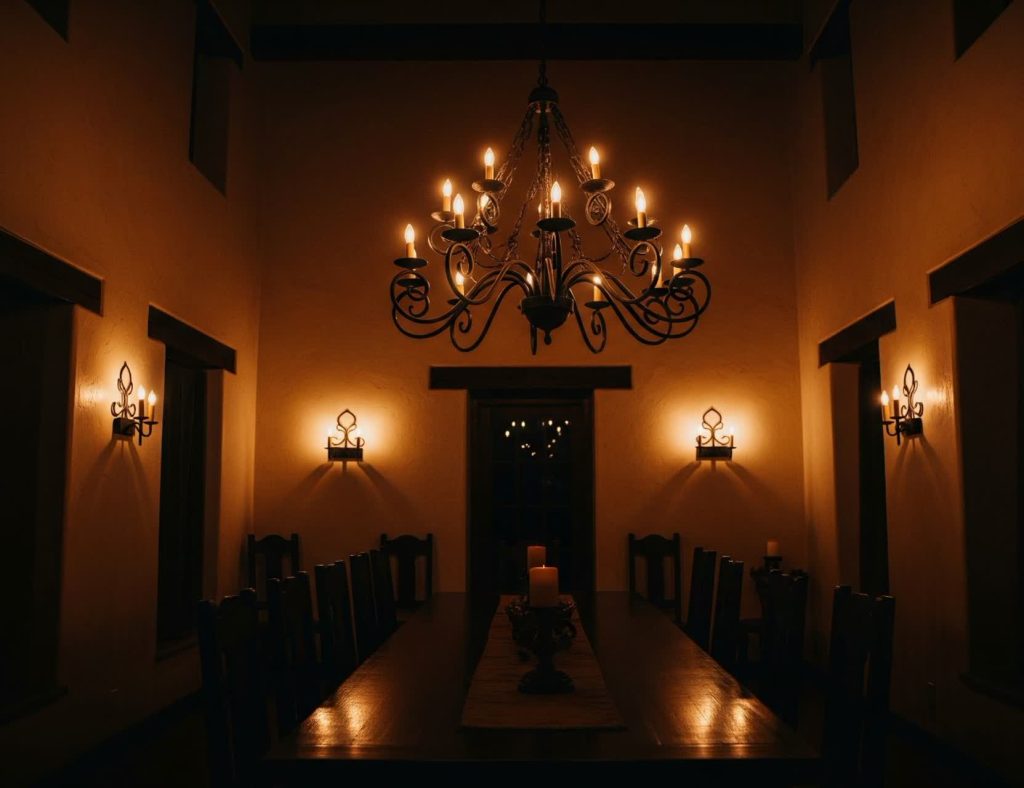
Modern Spanish Home Style: Blending Old and New
While it is based in tradition, Spanish home style has made stunning strides in integrating modern looks. Modern Spanish home style has a tendency to take the heart of the elements and make it simpler, using a lighter touch on ornament and letting the design breathe.
Some of the mainstream features of contemporary Spanish design are:
- Palettes Toned Down: While warm neutrals remain, the use of strong accents might be milder, so the texture and natural materials become the stars. This refined approach to Spanish home style is gaining popularity.
- Clean Lines: Pieces of furniture are still solid but less curvaceous in carving, more shape and grain of the wood.
- Open Floor Plans: Modern versions have a tendency to favor open, unobstructed floors that allow more flow and daylight.
- Indoor-Outdoor Blending: Tall bifold doors or massive windows might blur the demarcation of indoor and outdoor spaces, taking full advantage of natural light and views, an echo of the traditional courtyards.
- Minimalist Touches: While not purely minimalist, modern Spanish homes can be less decorative, with fewer decorative pieces that really pop. Look to our Minimalist Interior Design Ideas post for advice on how to strip it back without losing charm.
This makeover demonstrates the flexibility of the Spanish look, proof that it can be both traditional and completely contemporary. This evolution in Spanish home style is remarkable.
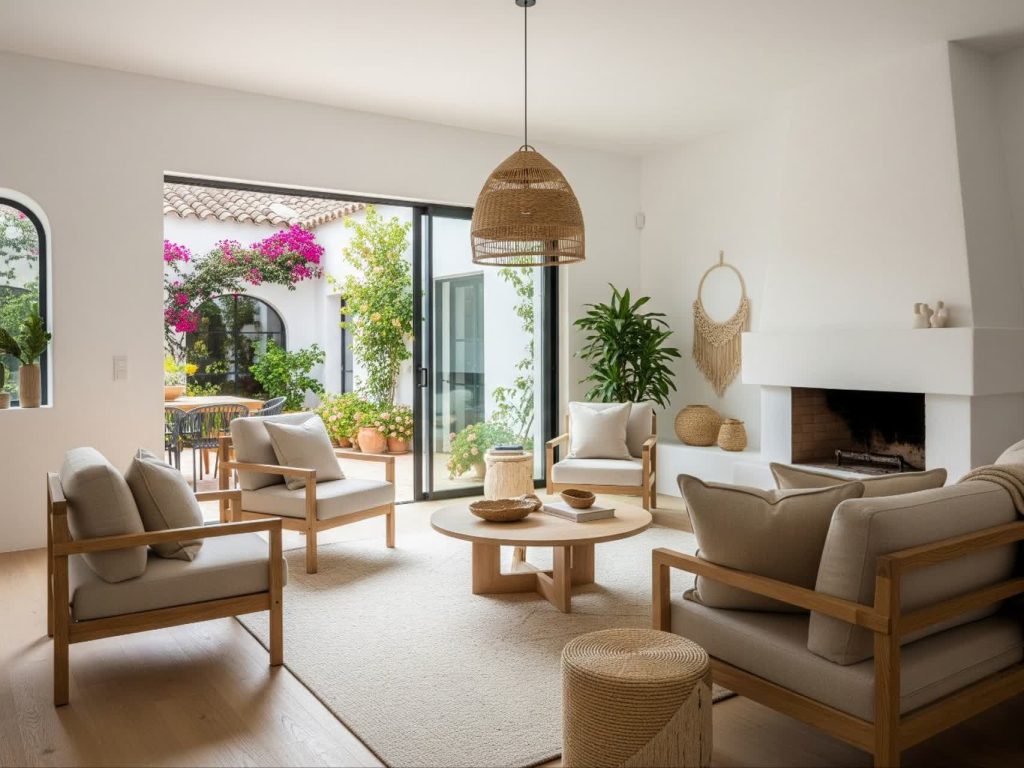
Beyond the Walls: Spanish Style House Exterior and Outdoor Spaces
The Spanish residential style isn’t just beautiful inside. The outside and out-of-doors areas contribute equally well to achieving this magical appearance, truly embodying Spanish home style.
- Patios and Courtyards: They are the hubs of Spanish living, a transition area from the indoor living space for dining, entertaining, or simply sitting back and relaxing. They will often feature fountains, ornamental plants, and tile pattern inserts.
- Terracotta Planters: Adorning courtyards, patios, and balconies, these classic pots hold vibrant bougainvillea, geraniums, or citrus trees.
- Wrought Iron Gates and Fences: Providing security and aesthetic appeal, these elements often feature ornate scrollwork.
- Whitewashed Walls with Accents: Stucco on the outside is often a dazzling white, making a striking contrast to the red tile roofs and dark wood accents.
- Outdoor Fireplaces and Kitchens: For entertainers outside, an outdoor kitchen or a rustic fireplace will open up the living area and showcase the outdoor living lifestyle.
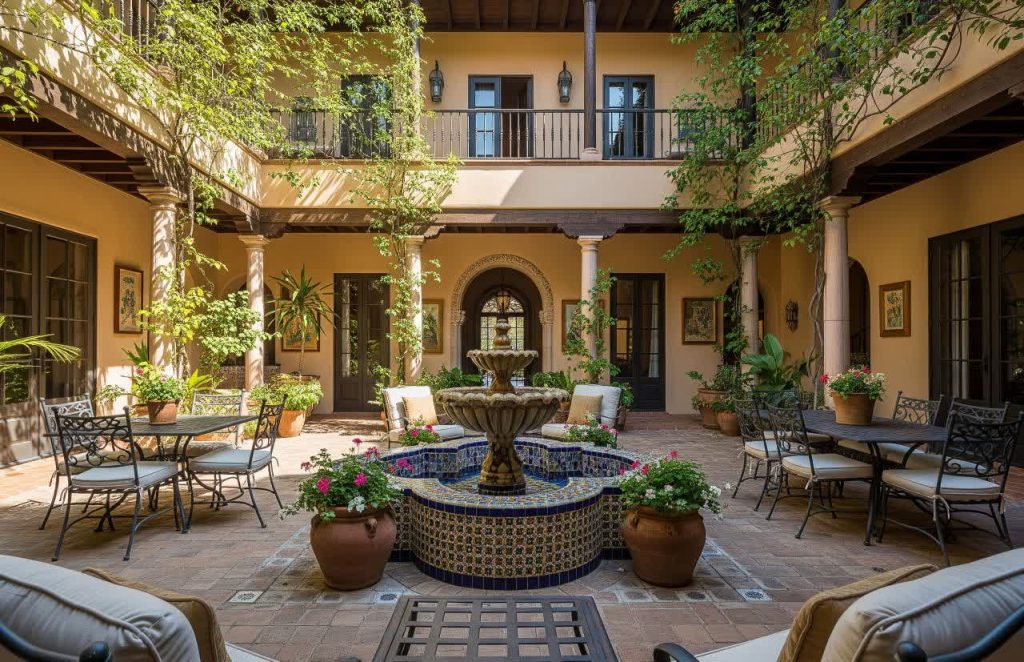
How to Make Your Home Spanish Style: Practical Tips
Ready to infuse your home with that zesty spirit of Spanish home design? Try these achievable tips:
- Start at the Base: If you can, begin with stucco walls and dark wood or terracotta flooring. These are a guaranteed show-stopper.
- Invite Arches: If you can’t build new arches, consider installing decoration archways or arched-top mirrors to mimic the look.
- Spend on Desirable Furniture: A carved console, dark wood dining table, or leather armchair creates the tone. Spend money on quality furniture that can withstand the years.
- Add Wrought Iron: This is an easy method of incorporating Spanish flair. Light fixtures, curtain rods, wall grilles, or small accent furniture are good choices.
- Layer with Textiles: Infuse warmth and color with throws, cushions, and rugs in deep textures and patterns.
- Add Hand-Painted Tiles: Employ them as kitchen backsplash, bathroom accent, or decorative coasters. The patterned colors are instantly identifying.
- Bring in Pottery and Ceramics: Highlight the hand-painted Spanish pottery, from large floor vases to decorative plates and bowls.
- Mind Your Lighting: Replace newer fixtures with wrought iron sconces or chandeliers. Add warm-toned bulbs for added warm ambiance.
- Don’t Forget the Outdoors: Create a small patio or balcony space with terracotta pots, water source, and comfortable seating.
- Embrace Natural Elements: Wood, stone, and iron are must-haves. Avoid too synthetic elements.
- Cultural Accents: Imagine tasteful Spanish landscape, flamenco dancer, or abstract design inspired by Moorish design work.
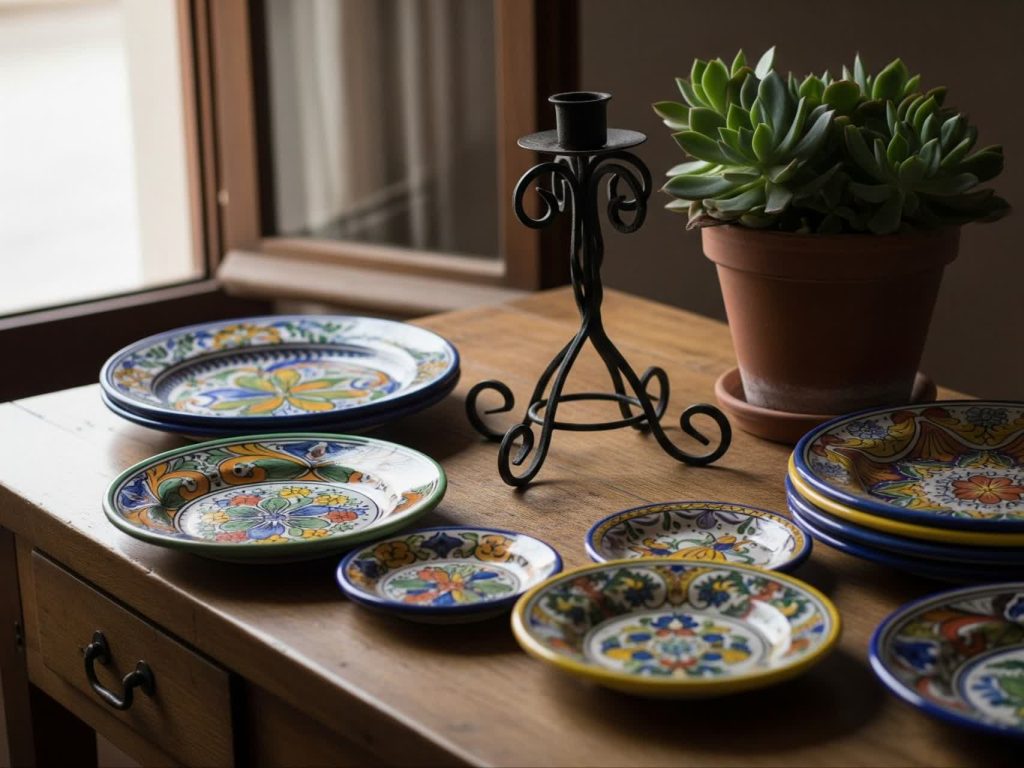
Spanish vs. Tuscan: The Tale of Two Styles
On other occasions, Spanish house style is differentiated from Tuscan style. While both originate from warm, Mediterranean climates and share similarities, the two have distinct features. Having knowledge of these differences can assist you in determining your preference for Spanish home style.
- Spanish Style: Is characterized by whitewashed or light stucco fronts, red barrel-tile roofs, and copious uses of dark wood and wrought iron. Bright blues, greens, and reds are part of the color scheme that frequently appear as patterned tile design. Interiors are rustic and sophisticated and flamboyant in their artwork, with elements like exquisite carvings and colorful fabric. This is the essence of Spanish home style.
- Tuscan Style: (Read more in our Guide to Tuscan Home Style) Tends to like warmer, earthier colors including ochre, terracotta, and olive green on the exterior. Stone is a more robust material used both inside and outside, with visible stone walls and fireplaces being common features. While also rural, Tuscan style will be slightly more polished and less overtly ornate than Spanish, with a focus on natural imperfections and a bit more weathered look. Wrought iron is utilized, but perhaps less with flair. Both aim to express warmth and sympathy for nature, but with Spanish there will be a more flamboyant, more fanciful application of color and more focus on intricate, hand-worked details.
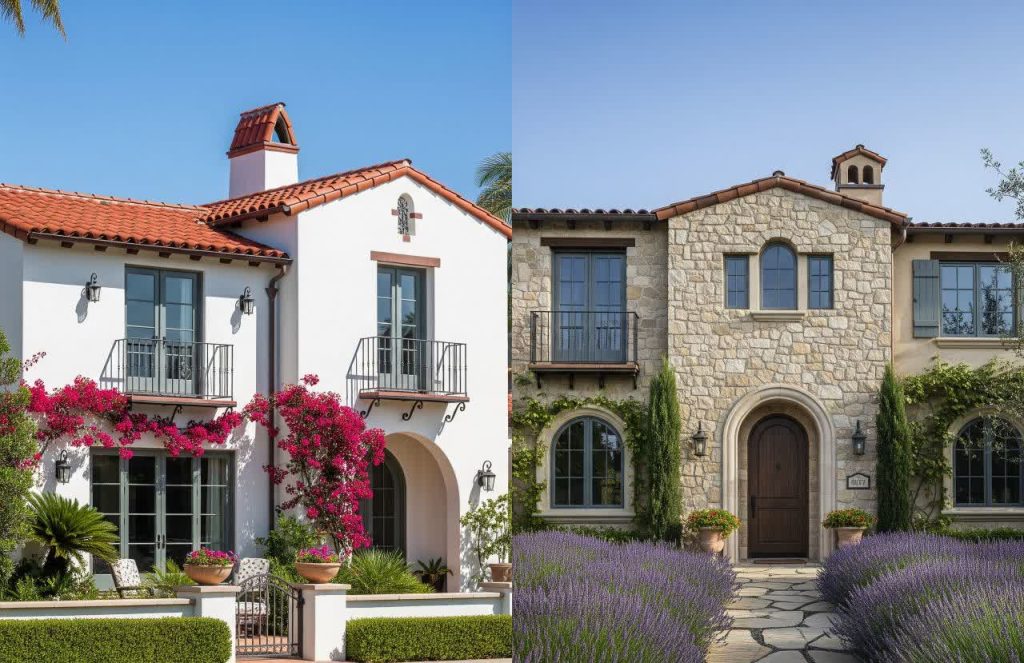
The Evolution: From Old Spanish House Design to Contemporary Chic
The development of Spanish residential architecture from its beginnings in history to modern interpretations is interesting. Early Spanish Colonial and Mission Revival types, particularly prevalent throughout the American Southwest and California, borrowed plentifully from the Spanish colonists’ architectural traditions. The homes were designed for functional purposes compatible with hot climate conditions with the added feature of enclosed courtyards for both shade and privacy. This foundation shaped modern Spanish home style.
As time went by, with design tastes ripening, the Spanish style lost some of its heavier, more ornate elements in favor of a lighter, more ethereal environment.
But the fundamentals of natural materials, human touch, and harmony with indoor-outdoor living remained. Presently, designers mix vintage Spanish heirlooms with stylish modern pieces, bringing about environments that are both traditional and entirely fresh. This adaptability is one of the reasons for the popularity of the Spanish home style among a large group of people, from history buffs to modern minimalists.
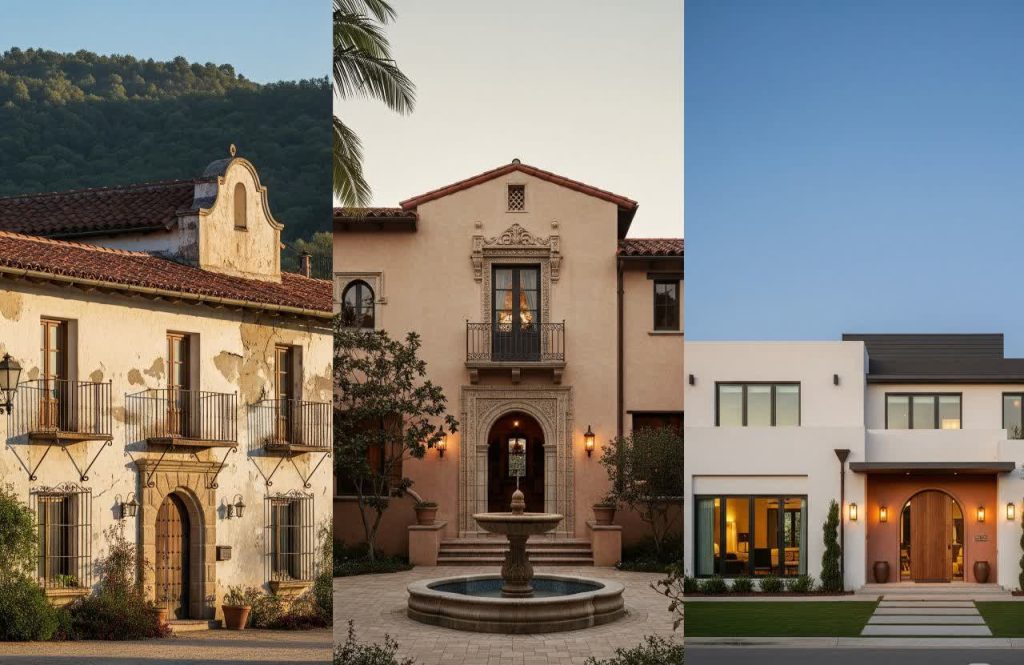
Final Thoughts: Welcome the Spanish Soul
Embracing Spanish home style is not merely a matter of choosing a decorative theme; it’s a matter of incorporating a way of life that is warm, passionate, and visually enamored with beauty and artistry into your home. It’s a matter of creating a space that invites, is lived in, and full of personality. This embodies the true spirit of Spanish home style.
Don’t be afraid to mix and match. Perhaps you adore the colorful tiles but not so much the shiny furniture. Or perhaps you are attracted to the rustic beams but want lighter shades of color on your walls. The beauty of Spanish house design is in its versatility and its ability to be adapted according to one’s taste without diminishing its original appeal.
So, are you ready to bring a little bit of Spain’s undeniable allure to your home? Let the rich colors of the sunbaked Spanish landscape, the artisanal textures, and the rich history of Spanish home style ignite your next decorating project. Share with us in the comments below your ideas and progress – we can’t wait to see how you’re bringing this amazing style to life!
For more inspiration for unique home styles, be sure to look at our further guides, such as the Adobe Home Style Guide.
FAQ: Your Burning Spanish Home Style Questions Answered
Picture Description: A stylized FAQ banner, perhaps featuring a simple drawing of a Spanish archway or a pattern tile.
Q1: What is the Spanish style house referred to as?
A1: While generally described as a “Spanish-style house,” such homes draw architectural inspiration from various movements like Spanish Colonial, Mission Revival, Pueblo Revival, and Mediterranean Revival. All of them have certain peculiarities but have common features drawing inspiration from Spanish traditional design and architecture, truly embodying Spanish home style.
Q2: What does the typical Spanish house look like?
A2: A typical Spanish house will feature thick, light-hued stucco walls (often white or cream), red tile low-pitched roof (barrel tiles are common), and arched window and doorway entrances. Exterior decorative wrought iron details are prevalent and dark wood beams, terracotta or patterned tile floors, and rustic, often carved, wood furniture are typical for interiors. Courtyards or patios also feature, easily integrating with indoor living spaces, all characteristic of Spanish home style.
Q3: Designing your home Spanish style.
A3: To make your house Spanish style, highlight the following major elements:
- Color Scheme: Use warm neutrals (white, cream) as a base, complemented by earthy tones (terracotta, rust) and bold accents of blue, green, or red.
- Materials: Focus on natural materials like stucco, terracotta, dark wood, and wrought iron.
- Architectural Features: Insert arches (via doorways, mirrors, or decoration), wooden beams, and elaborate ironwork.
- Floors: Employ terracotta tiles or dark wood floors. Accent with patterned tiles.
- Furniture: Choose heavy, lavish, generally carved, dark wood furniture and wrought iron, perhaps leather-covered furniture.
- Textiles: Insert opulent, textured fabrications, embroidered throws, and hand-woven rugs.
- Decor: Adorn with hand-painted pottery and ceramics, and strategically placed lighting fixtures like iron chandeliers.
Q4: How does Spanish style differ from Tuscan style?
A4: While both are warm, Mediterranean-style, they do vary:
- Spanish Style: Emphasizes white or light stucco, red barrel tile roofing, and heavy use of dark wood and ornate wrought iron. It will have more highly saturated, bolder color accents (especially in tiles) and perhaps a more overtly decorative and artful quality to it. This defines Spanish home style.
- Tuscan Style: Tends to gravitate towards warmer, earthier color palettes (ochre, olive green, colors of stone) and a greater incorporation of natural stone, both inside and out. More rough-hewn and rural in appearance, with more weathered, aged finishes and a slightly less elaborate appearance than traditional Spanish style.
